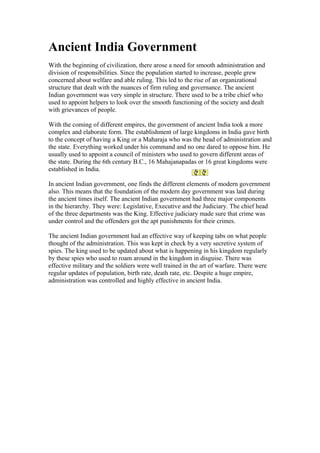
Ancient india government
- 1. Ancient India Government With the beginning of civilization, there arose a need for smooth administration and division of responsibilities. Since the population started to increase, people grew concerned about welfare and able ruling. This led to the rise of an organizational structure that dealt with the nuances of firm ruling and governance. The ancient Indian government was very simple in structure. There used to be a tribe chief who used to appoint helpers to look over the smooth functioning of the society and dealt with grievances of people. With the coming of different empires, the government of ancient India took a more complex and elaborate form. The establishment of large kingdoms in India gave birth to the concept of having a King or a Maharaja who was the head of administration and the state. Everything worked under his command and no one dared to oppose him. He usually used to appoint a council of ministers who used to govern different areas of the state. During the 6th century B.C., 16 Mahajanapadas or 16 great kingdoms were established in India. In ancient Indian government, one finds the different elements of modern government also. This means that the foundation of the modern day government was laid during the ancient times itself. The ancient Indian government had three major components in the hierarchy. They were: Legislative, Executive and the Judiciary. The chief head of the three departments was the King. Effective judiciary made sure that crime was under control and the offenders got the apt punishments for their crimes. The ancient Indian government had an effective way of keeping tabs on what people thought of the administration. This was kept in check by a very secretive system of spies. The king used to be updated about what is happening in his kingdom regularly by these spies who used to roam around in the kingdom in disguise. There was effective military and the soldiers were well trained in the art of warfare. There were regular updates of population, birth rate, death rate, etc. Despite a huge empire, administration was controlled and highly effective in ancient India.
